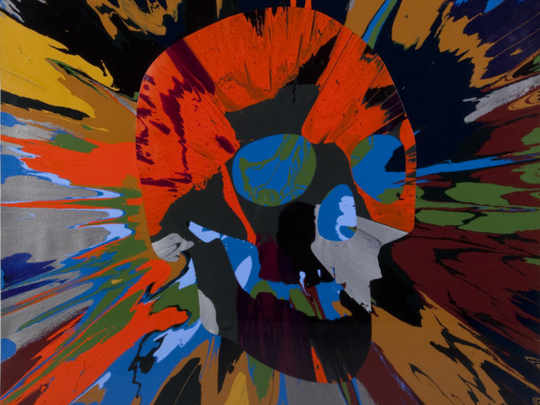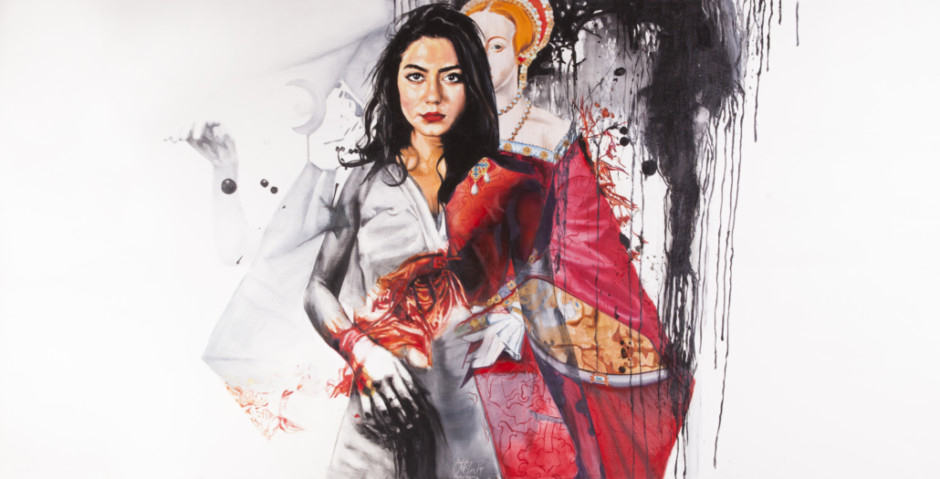
Iranian artist Afshin Pirhashemi is fascinated by the changing role of women in contemporary Iranian and Middle Eastern society, and their relationships with the world around them.
In his latest exhibition, “Femafia”, he examines their struggles in hostile environments through his dramatic, monochromatic, photorealistic portraits of strong women in combat mode, holding guns and swords. The title of the show alludes to the patriarchal society in the Middle East, and the mafia-like behaviour of certain governments and extremist groups, while also underlining the fact that unlike the mafia in the old days who kept women out of the dirty business, today’s mafias do not distinguish between men and women when it comes to terror and killings.
Pirhashemi’s portraits of beautiful women with long flowing tresses are influenced by classical depictions of idealised female beauty in Persian art, while also reflecting the contemporary Iranian woman’s obsession with achieving aesthetic perfection through cosmetic surgery. But they also express his innate respect of feminine strength.
Unlike the women in ancient Persian illustrations, Pirhashemi’s women are placed in unexpected and audacious situations that challenge age-old female stereotypes and break down gender-related barriers. Adding another layer to this narrative are portraits of Hollywood icons such as Marilyn Monroe, Marlon Brando and Al Pacino, and images from famous gangster films such as “Godfather” and “Scarface”.
“Women are so complex and have so many facets that I can paint them for a thousand years. I put the guns and swords in their hands not as a gesture of empowering them, but to symbolise their innate strength and power,” Pirhashemi says.
The artist has explored different aspects of femininity and the many roles women play in contemporary society. “Mothers” depicts a group of women, their black chadors contrasting sharply with the snow and clear sky around them. Some of these women hold swords and guns in their hands; some hide their faces behind masks; and some face the world defiantly. In the background can be seen a pack of wolves, and classical illustrations of warriors on horseback.
“I wanted to depict different kinds of mothers. Whether a person is a doctor who heals or a soldier who kills, everybody has been raised by a mother. The weapons in the hands of these mothers represent their strengths such as their love, kindness and the values they teach their children. But they also express my feeling that great and good mothers are a thing of the past,” the artist says.
“Kobani” deals with the role of women resistance fighters in the present conflict in Syria. The painting is inspired by the artist’s admiration for the courageous Kurdish women fighters who helped to wrestle control of the Northern Syrian town of Kobani from Daesh (the self-proclaimed Islamic State of Iraq and the Levant) militants. The leafless trees and ghostly figures in the background represent the death and devastation in Syria and the region, while the boats and the Statue of Liberty are symbols of the help that was awaited, but did not come. The glamorous look of the female soldiers comments on the transformation in the role of women in Middle Eastern society as well as on the stereotypical perception of the region by Western media.
In “Godfather”, Pirhashemi has used the iconic image of Marlon Brando as a mafia don. By surrounding this embodiment of male power with a mob of gun-wielding women, the artist aims to subvert the patriarchal norms of Middle Eastern society. On the other hand, in “Dynasty” he uses Queen Elizabeth I as an enduring example of female power in Western history. The queen stands behind a young girl, enveloping her in her crimson gown symbolically empowering all of womankind with strength and possibility.
In sharp contrast, a poignant portrait of Marilyn Monroe speaks about the isolation and objectification of women and its tragic consequences.
An interesting appropriation of an iconic work is “Vitruvian Woman”. This is based on Leonardo da Vinci’s 15th century drawing “Vitruvian Man”, which shows the ideal proportions of man according to ancient Roman studies.
In his drawing, da Vinci rendered the idealised human figure with the geometry of classical architecture, drawing the body in several poses, with anatomical detail inside a circle, symbolising the cosmos. In his painting, Pirhashemi has placed a woman over the figure in a reproduction of da Vinci’s drawing, presenting her as the centre of the universe and as a generative yet destructive force in the cycle of life and death.
Jyoti Kalsi is an arts enthusiast based in Dubai.
“Femafia” will run at Ayyam gallery, DIFC until April 30.
Icons and a tribute
La Galerie Nationale is presenting a collection of iconic design objects and artworks by renowned designers and artists of the 20th century, including Ron Arad, Damien Hirst, Jean Prouve and Andy Warhol in a show titled “Art Pulse”. Highlights of the show include “Skull on Spin”, an oil on paper diptych by Hirst; a “lobster” print by Warhol; and Arad’s famous “Big Easy” thermo form armchair.
Collectors also have the rare opportunity to buy a set of six oak “Standard” chairs. The Standard, chair, designed in 1934 by Prouve for a competition to furnish the student residence halls at the Cite Universitaire in Nancy is one of the famous designer’s early masterpieces, and is considered to be one of the true timeless classics in the history of furniture.
Also on display is a stunning sculptural installation made with steel, sand and Smart Acoustic Green technology, designed by Italian designer Aldo Cibic. The work, titled “Green Dunes”, is the designer’s tribute to Dubai, and a celebration of life. It is based on Cibic’s research into “micro-landscaping” and speaks about the transformation of the desert dunes into lush green hills in this fast-developing city. The mirror frame blurs the boundary between the installation and the viewer, playing with the idea of a mirage.
“As Dubai gains the confidence of the international collector, we wanted to produce a show that moves us beyond cliché and rebels against Western perception. We hope this show will appeal to serious investors and design enthusiasts alike,” gallery director Guillaume Cuiry says.
Jyoti Kalsi is an arts enthusiast based in Dubai.
“Art Pulse” will run at La Galerie Nationale, Al Quoz until April 27.














